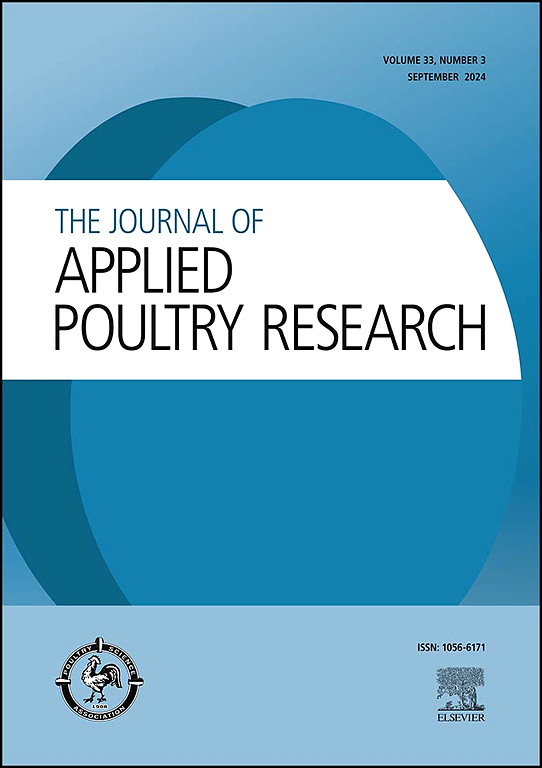添加螺旋藻对黄曲霉毒素B1暴露肉鸡生长、免疫、抗氧化状态和病理形态学的影响
IF 2
3区 农林科学
Q2 AGRICULTURE, DAIRY & ANIMAL SCIENCE
引用次数: 0
摘要
本试验旨在评价添加螺旋藻(SP)对黄曲霉毒素B1(AFB1)肉鸡生长、免疫、抗氧化状态、肝肾功能、胴体标准和病理形态学的影响。选取200只1日龄无性肉鸡(Ross 308),分为4个处理饲粮组,每组50只。每个处理设5个重复,每个重复10只鸡。每组均给予特定的膳食补充。1组饲喂不添加添加剂的基础饲粮。2组饲粮中添加2.5 mg/kg AFB1。3组饲喂螺旋藻添加量为1 g/kg的饲粮。第4组饲喂AFB1水平为2.5 mg/kg、螺旋藻水平为1 g/kg的饲粮。试验期6周(1 ~ 42 d)。AFB1毒性显著(P <;0.05)降低了最终活重和增重,而添加螺旋藻可提高最终体重和增重。此外,添加螺旋藻显著提高了饲料系数(P <;0.05)。AFB1毒性显著(P <;0.05)显著降低胴体重和屠宰率,但螺旋藻添加量显著降低(P <;0.05)胴体重、屠宰率和赤霉素率均高于对照组。AFB1毒性显著(P <;0.05)升高血中谷丙转氨酶(ALT)、天冬氨酸转氨酶(AST)和碱性磷酸酶(ALP)的浓度(P <;0.05)。与未添加SP的AFB1中毒肉鸡相比,在AFB1污染肉鸡饲粮中添加SP可降低ALT、AST和ALP浓度(P <;0.05)。在不添加SP的AFB1饲粮中,尿素和肌酐浓度显著升高(P <;0.05),但SP显著降低了尿素和肌酐浓度(P <;0.05)。AFB1毒性显著(P <;0.05)增加了总胆固醇、甘油三酯、低密度脂蛋白(LDL)和甚低密度脂蛋白(VLDL)的浓度,但SP的添加导致总胆固醇、甘油三酯、低密度脂蛋白和甚低密度脂蛋白的浓度降低。AFB1毒性使SOD和GPx活性降低(P <;0.05)。相反,SP可提高肉仔鸡SOD、GPx、过氧化氢酶(CAT)和总抗氧化能力(TAC)。相反,SP降低了AFB1肉鸡的MDA水平,尽管AFB1肉鸡的MDA水平较高(P <;0.05)。AFB1毒性显著(P <;0.05)降低了吞噬指数,而饲料中SP提高了吞噬活性和吞噬指数。综上所述,在肉鸡饲粮中添加SP是一种降低AFB1毒性影响、改善生长、免疫、抗氧化状态、肝肾功能、胴体标准和病理形态学的新策略。本文章由计算机程序翻译,如有差异,请以英文原文为准。
Effect of spirulina supplementation on growth, immunity, antioxidant status and pathomorphological perspectives in broilers exposed to dietary aflatoxin B1
The principal goal of this study was to evaluate the effect of Spirulina (SP) supplementation on growth, immunity, antioxidant status, liver and kidney functions, carcass criteria and pathomorphological perspectives in broilers given Aflatoxin B1(AFB1) in their diet. Two hundred (200) unsexed, 1-day-old broiler chicks (Ross 308) were divided into four treatment diet groups, each consisting of 50 birds. There were five replicates of each treatment (10 birds for each). Each group received specific dietary supplementation. Group 1 was fed a basal diet without additives. Group 2 was fed a diet with 2.5 mg/kg of AFB1. Group 3 was fed a diet with 1 g/kg of Spirulina. Group 4 was fed a diet with 2.5 mg/kg of AFB1 and 1 g/kg of Spirulina. The study lasted for six weeks (1–42 day). AFB1 toxicity significantly (P < 0.05) reduced final live body weight and weight gain whereas spirulina supplementation increased final body weight and weight gain. Moreover, spirulina supplementation significantly improved the feed conversion ratio (P < 0.05). AFB1 toxicity significantly (P < 0.05) decreased carcass weight and dressing percentage but spirulina supplementation significantly (P < 0.05) increased carcass weight, dressing percentage and giblet percentage relative to control. AFB1 toxicity significantly (P < 0.05) raised the blood concentrations of alanine transaminase (ALT), aspartate transaminase (AST) and alkaline phosphatase (ALP) (P < 0.05). Including SP in broiler diets contaminated with AFB1 decreased ALT, AST, and ALP concentrations relative to broilers intoxicated with AFB1 without SP (P < 0.05). The urea and creatinine concentrations were significantly elevated in broilers fed AFB1 diet with no SP (P < 0.05), but SP significantly lowered urea and creatinine concentrations (P < 0.05). AFB1 toxicity significantly (P < 0.05) increased the concentrations of total cholesterol, triglycerides, low-density lipoprotein (LDL) and very low-density lipoprotein (VLDL) however, the addition of SP resulted in a decrease in the concentrations of total cholesterol, triglycerides, low-density lipoprotein, and very low-density lipoprotein. AFB1 toxicity reduced the activity of SOD and GPx (P < 0.05). In contrast, SP elevated the SOD, GPx, catalase (CAT) and total antioxidant capacity (TAC) in broilers. Conversely, SP reduced the levels of MDA in broilers given AFB1, even though the levels of MDA was higher in broilers given AFB1 (P < 0.05). AFB1 toxicity significantly (P < 0.05) decreased the phagocytic index whereas dietary SP improved phagocytic activity and phagocytic index. In conclusion, using SP in broiler diets is considered a novel strategy for lowering the toxic impacts of AFB1 and improving growth, immunity, antioxidant status, liver and kidney function, carcass criteria and pathomorphological perspectives.
求助全文
通过发布文献求助,成功后即可免费获取论文全文。
去求助
来源期刊

Journal of Applied Poultry Research
农林科学-奶制品与动物科学
CiteScore
4.10
自引率
10.50%
发文量
80
审稿时长
104 days
期刊介绍:
The Journal of Applied Poultry Research (JAPR) publishes original research reports, field reports, and reviews on breeding, hatching, health and disease, layer management, meat bird processing and products, meat bird management, microbiology, food safety, nutrition, environment, sanitation, welfare, and economics. As of January 2020, JAPR will become an Open Access journal with no subscription charges, meaning authors who publish here can make their research immediately, permanently, and freely accessible worldwide while retaining copyright to their work. Papers submitted for publication after October 1, 2019 will be published as Open Access papers.
The readers of JAPR are in education, extension, industry, and government, including research, teaching, administration, veterinary medicine, management, production, quality assurance, product development, and technical services. Nutritionists, breeder flock supervisors, production managers, microbiologists, laboratory personnel, food safety and sanitation managers, poultry processing managers, feed manufacturers, and egg producers use JAPR to keep up with current applied poultry research.
 求助内容:
求助内容: 应助结果提醒方式:
应助结果提醒方式:


